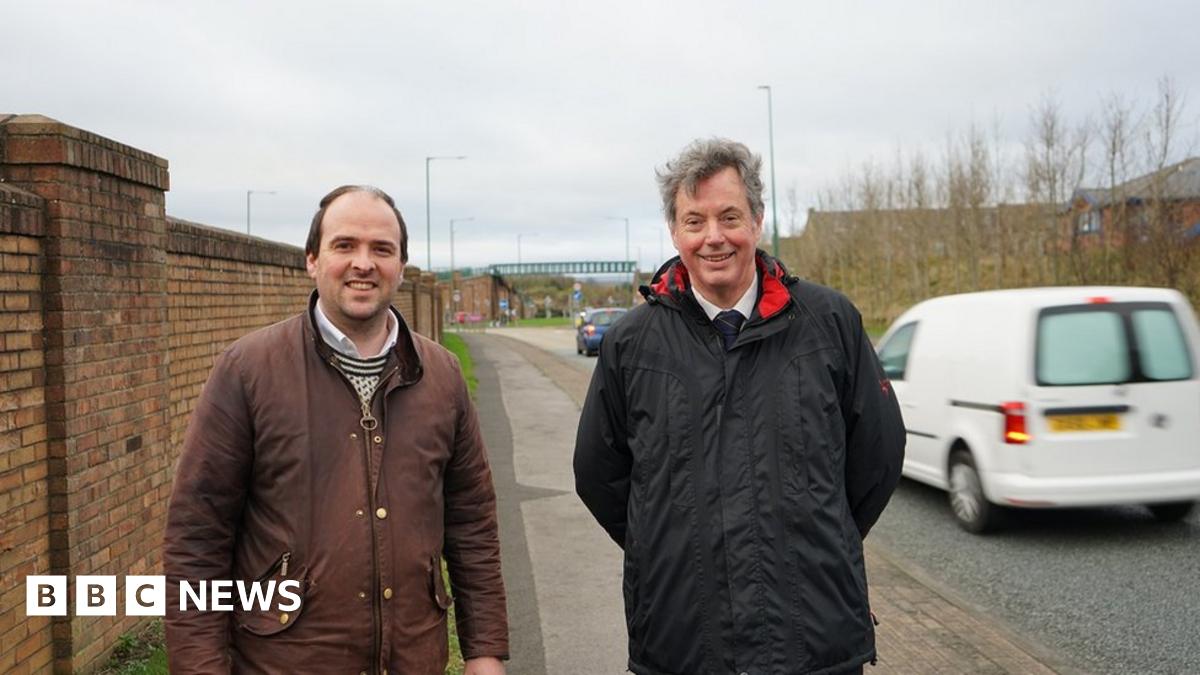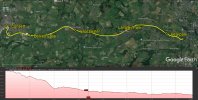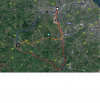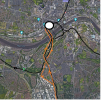The most viable route in my opinion is the Annfield Plain route. The majority of the old trackbed remains clear, although some short sections of new alignment (or compulsory purchases) would be needed through Annfield Plain and Leadgate. There is (just about) enough space for a single platform terminus in Consett where the original station was located alongside the A692, although there'd be no space for additional platforms, nor would it be possible to extend towards Rowlands Gill or Lanchester in the future. The site of the original Consett station would only work for the Annfield Plain route, were either the Rowlands Gill or Lanchester routes to be built a different station site, likely further from the Town Centre, would have to be found.
At it's closest approach the Annfield Plain route comes about 450 metres from Stanley Town Centre, not unreasonable at all to expect people to walk that, although the issue there is the height difference - the town is 30 metres higher than the rail alignment. An Ebbw Vale style solution could work there, with a modern iteration of a funicular to get people from the station up the hill into the town. I'm not sure the business case would be there for a station nearer the town centre as well as one in Shieldrow, though you could potentially argue that both stations would bring in additional demand that wouldn't be met by the other of the two stations alone.
A station in Beamish village could likely be justified by demand just for Beamish Museum during the summer months, although whilst the museum is closed it would be little used. A basic station there that was only served whilst the museum is open, perhaps an hour or two either side of opening and closing for staff to use too, but skipped at other times would I reckon be the best option for a station in Beamish
I'm not sure there would be much of a case for a station serving South Pelaw as it would primarily abstract revenue from Chester-le-Street. It could be argued that a station in South Pelaw with a frequent service to Newcastle would be well used with there being residential land adjacent, but the DFT would almost certainly try using that as an excuse to wind down the already poor service for Chester-le-Street. Anyone wanting the centre of Chester-le-Street or anywhere on the east and south sides of the town simply wouldn't consider going to South Pelaw for a train and would travel by other means instead. I'm not saying don't build a station for South Pelaw, although safeguards would need to be put in place to ensure that a station in South Pelaw wouldn't be to the detriment of Chester-le-Street.
Next there's the route via Lanchester. Starting at the Consett end, the closest you'd likely get a station for this route to the town centre is next to Tesco. Whilst not too far for people to walk, it wouldn't be as convenient a location for the town centre as the Annfield Plain route would offer.
There would be relatively few issues to overcome until joining the ECML, which is where the major hinderance to this route lies. Without a new diversion for the ECML to allow faster services to bypass Durham altogether (which would need to diverge no further north than Tursdale, and rejoin no further south than Ouston Junction), the Lanchester route is a non starter. The terrain would prevent a grade seperated junction to connect the Lanchester route to the ECML south of Durham, which would mean that even if a bypass line was built for faster ECML services, Consett trains would be limited in frequency to a maximum, realistically, of 1TPH. A line for the ECML to bypass Durham would make the cost of the Lanchester route prohibitively expensive, and therefore for that reason I'd go as far as saying it's effectively ruled out.
Finally the Rowlands Gill route, there's a few issues with this option which I'll break down, and as with the other two routes I'll work from Consett towards Newcastle. Unless you're going to tunnel under Consett and build an underground station in the Town Centre, the closest you'll get a station is in Blackhill, more than a kilometre away from the town centre. Newer housing developments have taken up a significant chunk of the old alignment and would prevent the railway from getting any closer to the town centre above ground. An underground station would likely push the price range out of anything the DFT would consider, and a station in Blackhill would be too far away from the town centre for many people to consider using it over a bus to/from the Bus Station.
The next issue to overcome would be in Rowlands Gill. Retirement bungallows have been built on the former railway alignment through the town, and as the terrain would make any alternative route near impossible to build compulsory purchase orders would be needed, covering around 25 homes.
Finally there's the issue of connecting up with the Tyne Valley line. The alignment through Swalwell is mostly now occupied by roads and there's little scope for a new railway alignment, however the original alignment could be reused by a tram-train using a bit of street running, so wouldn't neccessarily be something to rule out. A tram-train would also overcome the issue of station access in Consett, as street running would allow access beyond Blackhill into the town centre.
My conclusion here is that for a heavy rail link the only viable route is the Annfield Plain route. However the Rowlands Gill route could be viable with a tram-train, and indeed I would be interested to see a benefit-cost analysis for a tram-train via this route - if integrated with the Metro network a tram-train via the Rowlands Gill route could be quite popular.
Again, a nice idea on paper but it would slow things down. On the other hand, there is a redundant concrete-built shunting ramp at Tyne Yard that may be of use in that regard; however it could only hold a single line even in its heyday. Also there is the matter of South of Birtley Junction/Tyne Yard, where there are only two tracks remaining to the divergence point at Ouston Junction (ECML crossover site) and a few bridges where the spare area between the ECML and the boundary fence has either been partly filled in (Bridge Repairs/Strengthening) or small bits appropriated for various Railway Communications/Equipment boxes.
The only bridge that's been partly filled in between Tyne Yard and Ouston Junction is Station Lane in Birtley. That bridge could do with replacing regardless what happens with a rail link to Consett/Stanley as it's not strong enough to handle traffic in both directions at the same time (having lights to control the traffic flow despite being wide enough for two lanes as a result), and is a major bottleneck for the road network. A new bridge could easily leave space for slow lines (and even a station for Birtley) underneath. The other bridge over the ECML in that area, Drum Road, could accommodate new slow lines under it without any work to the bridge itself.






